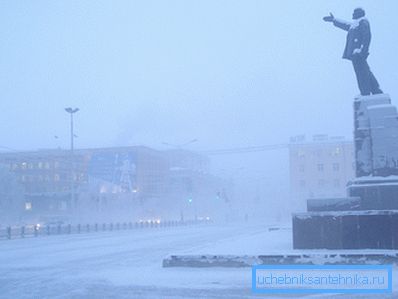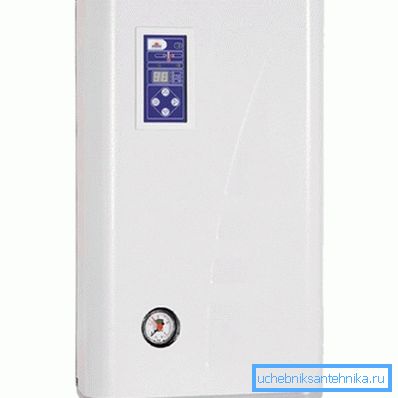Specific heat consumption for building heating: familiarity
What is it - specific heat consumption for heating? In what quantities is the specific heat consumption for the heating of a building measured and, most importantly, where does its value for calculations come from? In this article we have to get acquainted with one of the basic concepts of heat engineering, and at the same time explore several related concepts. So go.

What it is
Definition
The definition of specific heat consumption is given in SP 23-101-2000. According to the document, this is the name of the amount of heat needed to maintain the normalized temperature in the building, referred to the unit of area or volume and to another parameter - the degree-day of the heating period.
What is this parameter used for? First of all - to assess the energy efficiency of the building (or, what is the same thing, the quality of its insulation) and to plan the cost of heat.
Actually, SNiP 23-02-2003 directly states: the specific (per square or cubic meter) consumption of thermal energy for heating the building should not exceed the given values. The better the insulation, the less energy requires heating.
Degree day
At least one of the terms used needs clarification. What is it - degree-day?
This concept directly refers to the amount of heat needed to maintain a comfortable climate inside a heated room in winter. It is calculated by the formula GSOP = Dt * Z, where:
- GSOP - the desired value;
- Dt - the difference between the normalized internal temperature of the building (according to the current SNiP it should be from +18 to +22 C) and the average temperature of the coldest five days of winter.
- Z is the length of the heating season (in days).
As it is easy to guess, the value of the parameter is determined by the climate zone and for the territory of Russia vary from 2000 (Crimea, Krasnodar Territory) to 12000 (Chukotka Autonomous Region, Yakutia).

Units
What values measure the parameter we are interested in?
- In SNiP 23-02-2003, kJ / (m2 * S * day) and, in parallel with the first value, kJ / (m3 * S * day) are used.
- Along with kilojoule, other units of measure of heat can be used - kilocalories (Kcal), gigacalories (Gcal) and kilowatt hours (KW * h).
How are they related?
- 1 gigacalorie = 1,000,000 calories.
- 1 gigacalorie = 4184000 kilojoules.
- 1 gigakaloriya = 1162.2222 kilowatt-hours.

Normalized parameters
They are contained in the annexes to SNiP 23-02-2003, tab. 8 and 9. We give excerpts from the tables.
For single-storey single-storey detached houses
| Heated area | Specific heat consumption, kJ / (m2 * C * day) |
| Up to 60 | 140 |
| 100 | 125 |
| 150 | 110 |
| 250 | 100 |
For apartment buildings, hostels and hotels
| Number of floors | Specific heat consumption, kJ / (m2 * C * day) |
| 13 | According to the table for single-family houses |
| 4 - 5 | 85 |
| 6 - 7 | 80 |
| 8 - 9 | 76 |
| 10 - 11 | 72 |
| 12 and above | 70 |
Please note: with increasing number of floors, the rate of heat consumption decreases. The reason is simple and obvious: the larger the object is a simple geometric shape, the greater the ratio of its volume to the surface area. For the same reason, the unit cost of heating a country house decreases with an increase in the heated area.

Calculations
The exact value of heat loss by an arbitrary building is almost impossible to calculate. However, methods of approximate calculations have been developed for a long time, which give fairly accurate average results within statistics. These calculation schemes are often referred to as calculations for aggregates (gauges).
Along with heat output, it is often necessary to calculate daily, hourly, annual heat consumption, or average power consumption. How to do it? Let's give some examples.
The hourly consumption of heat for heating according to enlarged meters is calculated by the formula Qot = q * a * k * (tвн-tno) * V, where:
- Qot is the desired value in kilocalories.
- q is the specific heating value of the house in kcal / (m3 * C * h). It is searched in reference books for each type of building.

- a - coefficient of correction for ventilation (usually equal to 1.05 - 1.1).
- k is the coefficient of correction for the climatic zone (0.8 - 2.0 for different climatic zones).
- tвн - internal temperature in the room (+18 - +22 С).
- tno - outdoor temperature.
- V is the volume of the building together with the enclosing structures.
To calculate the approximate annual heat consumption for heating in a building with a specific flow rate of 125 kJ / (m2 * C * day) and an area of 100 m2, located in a climatic zone with the parameter GSOP = 6000, you need only multiply 125 by 100 ( ) and at 6000 (degree-day of the heating period). 125 * 100 * 6000 = 75000000 kJ, or about 18 gigacalories, or 20,800 kilowatt-hours.
To recalculate the annual consumption of the average heating power of the heating equipment, it is enough to divide it by the length of the heating season in hours. If it lasts 200 days, the average heat output of heating in the above case will be 20,800 / 200/24 = 4.33 kW.
Energy sources
How to calculate the cost of energy with your own hands, knowing the heat consumption?
It is enough to know the calorific value of the corresponding fuel.
The easiest way to calculate the electricity consumption for heating a house: it is exactly equal to the amount of heat produced by direct heating.

Thus, the average power of an electric heating boiler in the last considered case will be equal to 4.33 kW. If the price of a kilowatt-hour of heat is 3.6 rubles, then we will spend 4.33 * 3.6 = 15.6 rubles per hour, 15 * 6 * 24 = 374 rubles per day, and so on.
It is useful for owners of solid fuel boilers to know that the consumption rate of firewood for heating is about 0.4 kg / KWh. Coal consumption for heating is half as much - 0.2 kg / KW * h.

Thus, in order to calculate the average hourly consumption of firewood with the average heat output of 4.33 kW, it is enough to multiply 4.33 by 0.4: 4.33 * 0.4 = 1.732 kg. The same instruction applies to other coolants - just enough to get into the directories.
Conclusion
We hope that our acquaintance with the new concept, even if somewhat superficial, could satisfy the reader’s curiosity. The video attached to this material, as usual. Will suggest additional information. Successes!